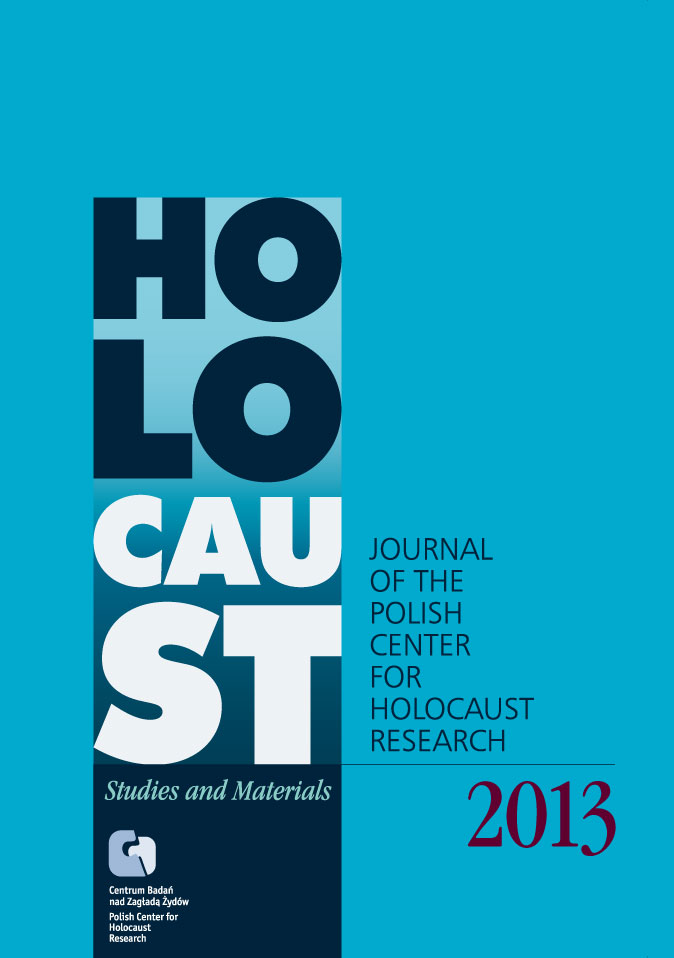Gone but not Forgotten: Archaeological approaches to the site of the former Treblinka Extermination Camp in Poland
Zagłada Żydów. Studia i Materiały, Nr Holocaust Studies and Materials (2013), Strony: 253-289
Data zgłoszenia: 2020-12-13Data publikacji: 2013-02-20
 https://doi.org/10.32927/zzsim.809
https://doi.org/10.32927/zzsim.809
Abstrakt
Public impression of the Holocaust is unquestionably centred on knowledge about, and the image of, Auschwitz-Birkenau – the gas chambers, the crematoria, the systematic and industrialized killing of victims. Conversely, knowledge of the former extermination camp at Treblinka, which stands in stark contrast in terms of the visible evidence that survives pertaining to it, is less embedded in general public consciousness. As this paper argues, the contrasting level of knowledge about Auschwitz-Birkenau and Treblinka is centred upon the belief that physical evidence of the camps only survives when it is visible and above-ground. The perception of Treblinka as having been “destroyed” by the Nazis, and the belief that the bodies of all of the victims were cremated without trace, has resulted in a lack of investigation aimed at answering questions about the extent and nature of the camp, and the locations of mass graves and cremation pits. This paper discusses the evidence that demonstrates that traces of the camp do survive. It outlines how archival research and non-invasive archaeological survey has been used to re-evaluate the physical evidence pertaining to Treblinka in a way that respects Jewish Halacha Law. As well as facilitating spatial and temporal analysis of the former extermination camp, this survey has also revealed information about the cultural memory associated with the site and how much has been forgotten about its history.
Licencja
Prawa autorskie (c) 2013 Autor & "Zagłada Żydów. Studia i Materiały"

Utwór dostępny jest na licencji Creative Commons Uznanie autorstwa 4.0 Międzynarodowe.
https://creativecommons.org/licenses/by/4.0
Inne teksty tego samego autora
- Caroline Sturdy Colls, O tym, co minęło, lecz nie zostało zapomniane: Badania archeologiczne na terenie byłego obozu zagłady w Treblince , Zagłada Żydów. Studia i Materiały: Nr 8 (2012)
Podobne artykuły
- Adam Kopciowski, Dariusz Libionka, Relacja działaczki Poalej Syjon-Lewicy Poli Elster o sytuacji na Umschlagplatzu i w transporcie do Poniatowej w kwietniu 1943 r , Zagłada Żydów. Studia i Materiały: Nr 19 (2023)
- Feliks Tych, Miriam Chaszczewacka’s Diary , Zagłada Żydów. Studia i Materiały: Nr Holocaust Studies and Materials (2013)
- Nawojka Cieślińska-Lobkowicz, Śmierć antykwariusza na Chłodnej , Zagłada Żydów. Studia i Materiały: Nr 12 (2016)
- Przemysław Nowicki, Łucja Pawlicka-Nowak (1938–2020) – badaczka Zagłady, prekursorka archeologii miejsc pamięci , Zagłada Żydów. Studia i Materiały: Nr 16 (2020)
- Michał Kowalski, "Wokół nas morze ognia' , Zagłada Żydów. Studia i Materiały: Nr 19 (2023)
- Anna Bikont, „Marzeniem pana Poteraja jak i moim jest, aby te niechlubne wydarzenia zostały opisane”. O zbrodni oddziału AK na Żydach ukrywających się na bagnach koło wsi Podosie w Łomżyńskiem , Zagłada Żydów. Studia i Materiały: Nr 18 (2022)
- Andrzej Żbikowski, Teksty pogrzebane w niepamięci. Relacje dwóch uciekinierek z masowego grobu Poniatowa , Zagłada Żydów. Studia i Materiały: Nr 1 (2005)
- Havi Dreifuss, Badania nad życiem religijnym Żydów w Polsce podczas Zagłady – główne źródła i podstawowe zagadnienia , Zagłada Żydów. Studia i Materiały: Nr 9 (2013)
- Szymon Redlich, Moralność i rzeczywistość: metropolita Andriej Szeptycki i Żydzi w czasach Holocaustu i II wojny światowej , Zagłada Żydów. Studia i Materiały: Nr 4 (2008)
- Ewa Wiatr, Ruch hachszarowy w getcie łódzkim 1940–1941 w świetle dokumentów. , Zagłada Żydów. Studia i Materiały: Nr 16 (2020)
<< < 1 2 3 4 5 6 7 8 9 10 11 12 13 14 15 16 17 18 19 20 21 22 23 24 25 26 27 28 29 30 31 32 33 34 35 36 37 38 39 40 41 42 43 44 45 46 47 48 49 50 > >>
Możesz również Rozpocznij zaawansowane wyszukiwanie podobieństw dla tego artykułu.
 English
English
 Język Polski
Język Polski








